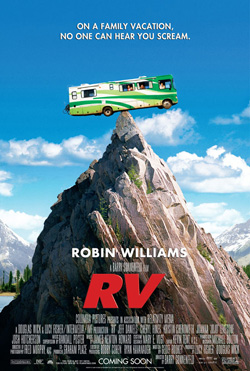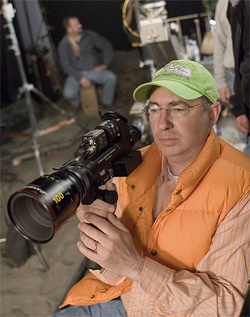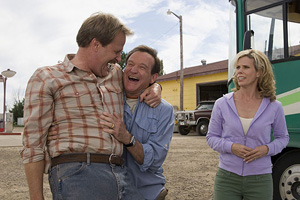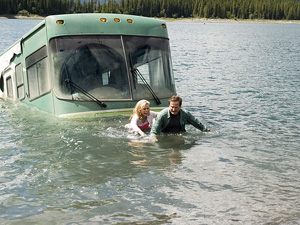 Ever since he left the world of cinematography (where he was, without a doubt, one of the greats, especially in his work with the Coen Brothers on films like Miller’s Crossing and Blood Simple) for the director’s chair, reading Barry Sonnenfeld’s resume can give you a serious case of whiplash. He’s gone from the heights of Get Shorty and the original Men in Black to the depths of Wild Wild West and Men in Black II, with a pit stop at Big Trouble, a movie that was completely creamed by the events of 9/11.
Ever since he left the world of cinematography (where he was, without a doubt, one of the greats, especially in his work with the Coen Brothers on films like Miller’s Crossing and Blood Simple) for the director’s chair, reading Barry Sonnenfeld’s resume can give you a serious case of whiplash. He’s gone from the heights of Get Shorty and the original Men in Black to the depths of Wild Wild West and Men in Black II, with a pit stop at Big Trouble, a movie that was completely creamed by the events of 9/11.
It’s been four years since Sonnenfeld has released a movie, and he’s come back in surprising style. Everything about RV screams that it just won’t be any good, and with another director and another cast, I think that would be true. But Sonnenfeld has gathered a truly fantastic bunch of comedic actors – Robin Williams is in more restrained mode as a put-upon soft drink executive who takes his family on a disastrous cross-country RV trip, Cheryl Hines proves that she’s the consummate “wife of,” and Jeff Daniels plays the flipside of his Squid & the Whale character as an RV lifer with his incredibly bizarre family. There are plenty of fine actors in smaller roles, as well, including Arrested Development’s Will Arnett as Williams’ germaphobic boss. They’ve ended up with a movie that is admittedly broad, and squarely aimed at a younger and family oriented audience, but still often very, very funny.
Q: So you make a very big cameo in this film.
Sonnenfeld: I thought it would be funny if the family drove a really hideous RV. So first what we did is we went to real manufacturers, Winnebago and that kind of stuff, and no one wanted to give us RVs unless they had control over what we did with them. So the next thing you know they say, ‘You can’t say the brakes are bad, you can’t say this, you can’t say that.’ So that wasn’t interesting to us.
So then we bought six white RVs and DP Fred Murphy and I spent a lot of time coming up with hideous paint schemes, which we eventually did. Greens that don’t exist in nature. Then I had them paint in really big orange letters “Rent Me,” because that would be really embarrassing and then I thought, what if there was a really big picture of me, as the dealer Irv, saying, ‘Rent it for a day or a lifetime.’ When the Coen Brothers and I were shooting Blood Simple we stayed at a place next to the Days Inn – not the Days Inn, but next to the Days Inn – on the interstate, and their slogan was ‘For a day or a lifetime,’ which was the most hideous thought. And in fact the Coens used it in Barton Fink, on the stationary it says ‘For a day or a lifetime.’
So anyway, Fred the DP and Graham the producer kept saying, ‘You know Barry, this is over the top.’ And Lucy and Doug Fisher, the producers, said, ‘You know what, we think it’s funny.’ So I put my picture on there. I made the photographer take my picture over and over again. In fact, my hands are a different picture than my face because I wanted my hands and my face to be in focus, and you couldn’t with the lens.
Anyway, we put it up there, and at first I’m embarrassed and then by the end of the shoot, I’m saying, ‘Do we need a close-up of Irv here? We’ll do one more take, but when the RV passes you have to pan up and zoom in on Irv.’ So my wife’s pretty upset about it, and there I am.
 Q: This movie is about a fairly neurotic guy traveling around with his family with a lot of technology. It reminds me of your column in Esquire.
Q: This movie is about a fairly neurotic guy traveling around with his family with a lot of technology. It reminds me of your column in Esquire.
Sonnenfeld: I have this monthly column in Esquire called The Digital Man, and a lot of it is about my neuroses, fears and my relationship with my wife Sweetie, as much as it is about the technology. I told Robin that he’s basically playing me in this movie. Everytime something goes wrong and you see Robin scream and be the first one fleeing, that would be me. I spent nights at home, we live out in the country, and I’ll hear a sound in the middle of the night and I’ll wake up my wife. ‘Sweetie, did you hear that?’ and she says, ‘The boiler kicked in.’ I say ‘No, no, no, there’s someone down there,’ and she says, ‘You want me to go look, don’t you?’ and I say, ‘You have to, please, please.’ So Sweetie gets out of bed, puts on her bathrobe, I hide under the cover and she comes back and reports that the boiler kicked in.
Every time you see Robin sort of dry-heave or gag, that’s me. I’m a sympathetic vomiter. If I see, smell or hear vomiting, I vomit also. So that is me in the movie, yes.
Q: Can you talk about the casting, especially with getting people who could do the musical numbers?
Sonnenfeld: We were totally lucky. I once directed a television pilot called Maximum Bob, and I cast this woman Kirsten Warren without asking her if she could eat a banana underwater, which was a requirement. It turns out that she could, she grew up in Hawaii and could eat a banana underwater, because she played a Wiki Wachi mermaid, and that’s what they do.
Q: I did not know that.
Sonnenfeld: Well, it’s quite a sight.
There are several things in this movie – Robin Williams, we wrote all the stuff for him on the bike without thinking about it and then it turns out that Robin owns seven bikes and he bikes and that’s what he does on his spare time. We ended up with a bike guy. So I discovered that we were doing this show with all these songs in it, and after I cast Kristin [Chenoweth] is when we put all the songs in. I wanted them to do something cloying and sweet without being obnoxious. We looked at a lot of songs. I asked Kristin, ‘Can you sing,’ and she said, ‘I’m a trained opera singer,’ so that was pretty good. Then I e-mailed Jeff and I said, ‘Hey Jeff, can you play any musical instruments?’ and he said, ‘I played the classical guitar for 25 years and I’m pretty good at the banjo.’ I emailed him back and said, ‘Any chance at the same time you could also play a harmonica with a neck brace,’ and he emailed me back saying, ‘I see where you’re going with this – I like it.’ Of course he can play the harmonica with the neck brace, but when we came up with the idea of the song, we had no idea. It was a lucky accident how well this people could sing.
It was also a lucky accident how horribly Cheryl [Hines] can sing. When we first recorded GTO she said, ‘Look let me tell you something. I’m going to sing now and you’re going to think I’m trying to be bad and tell me to stop being so funny. I’m about to sing it as well as I can ever sing it.’
Q: Whose idea was it to have the Gornicke family’s RV horn play the Star Trek theme?
Sonnenfeld: That was mine. We were trying to get the Godfather theme, which was very funny also. When we couldn’t get that they were getting me the Yellow Rose of Texas and stuff like that, but I was like, no, it has to be a big, recognizable, funny song. Actually Lucy Fisher and Doug Wick, the producers, were very helpful in convincing whoever owns that – I don’t know if it’s the Roddenberry family or the network, but anyway we got it.
Q: As one of the great former cinematographers you always had these great and wild shots, but in this film you only had one of those.
Sonnenfeld: I always felt this was a movie that shouldn’t have a self-conscious camera. I think it’s still pretty visual and the teeter totter stuff and the geyser are still pretty funny, but for me this was more about landscape and tableaux than the moving camera particularly.
Q: Was it hard for you to go there?
Sonnenfeld: No. Get Shorty didn’t have a lot of wacky stuff as well.
Q: I have seen the Steadicam being used to death lately. What’s the reason for that?
Sonnenfeld: It’s speed. Shooting with a Steadicam is much faster for two reasons. One, it’s much faster than putting down dolly tracks and leveling it and all that, although dolly moves are much more specific, and have a specific beginning and end. You feel a confidence in that move.
much faster than putting down dolly tracks and leveling it and all that, although dolly moves are much more specific, and have a specific beginning and end. You feel a confidence in that move.
The other reason it’s faster is because it weighs a lot, and the crew wants to help the Steadicam guy; they work much faster. Once you put a Steadicam on a guy you don’t screw around with the lighting and stuff. I just directed a television pilot and we had eight days to do it, and I’d say we used Steadicam 75% of the time. I didn’t like it, but I got through the days.
What’s worse is handheld for no reason. Sometimes it works because it gives you a certain energy. But it’s also a cost reason – if you look at Mean Streets, the Scorsese movie, that’s all handheld, even wideshots where there’s no reason. That gives you a little bit of tension, but the handheld makes you nauseous when it’s not handled properly. But it’s all about speed and money and nothing to do with aesthetic decision making.
Q: As a former cinematographer how do you work with the cinematographers in your films?
Sonnenfeld: When I became a director the first movie I directed was The Addams Family. I looked at all the cinematographers that had tried to be directors; Gordon Willis did Windows, John Alonzo did FM, Fraker did Legend of the Lone Ranger. These were all brilliant cinematographers, and none of them made the successful transition. What I noticed about them in all those cases is they took their camera operator and made them their DP, which meant ‘I don’t want to give up being a DP. I’m afraid of all those actors, I want to stick with what I know, I’m going to move my operator up,’ so what I felt is that if I wanted to be a successful director (which I didn’t want to be. Scott Rudin forced me to direct Addams Family. I was very happy being a DP and I was not saying ‘I can do a better job than him or her) I had to hire a DP who was so good, so much better than me, I wouldn’t dare saying “What if we moved the camera over to…” So I hired Owen Roizman, who’s one of the greats. I still wanted to design the shots and to this day I still design the shots, but you do that in pre-production. I said I didn’t want to have anything to do with the camera or the lighting except to design the shots. To this day I hire really good cameramen just for that reason.
In fact the only time I ever said, ‘You know that [light’s] in the wrong place,’ was on Get Shorty, and I fired that guy and hired Don Peterman, who was great. I stay out of the lighting entirely, and get very involved in pre-production. I line up the shots and the DPs don’t seem to mind.
Q: When you hire people like Robin and Cheryl and Will Arnett, it seems like you’re going for a film that will be at least partially improv’d.  Sonnenfeld: Absolutely not! The only improv stuff we did – and I wouldn’t even call it improv – was Robin’s stuff. I’m still a control freak, and I still don’t like surprises on the set. With Robin what we did was three or four takes as scripted and then I would just say, ‘So Robin, you got any ideas, you want to try some stuff?’ And he did, and some of the stuff we would use and some we wouldn’t. But Robin was the only case where – we didn’t like rehearse improvisationally and discover things and stuff like that. Will and Cheryl are on book. I think Cheryl is incredibly funny; I think she’s like Mary Tyler Moore funny.
Sonnenfeld: Absolutely not! The only improv stuff we did – and I wouldn’t even call it improv – was Robin’s stuff. I’m still a control freak, and I still don’t like surprises on the set. With Robin what we did was three or four takes as scripted and then I would just say, ‘So Robin, you got any ideas, you want to try some stuff?’ And he did, and some of the stuff we would use and some we wouldn’t. But Robin was the only case where – we didn’t like rehearse improvisationally and discover things and stuff like that. Will and Cheryl are on book. I think Cheryl is incredibly funny; I think she’s like Mary Tyler Moore funny.
But with Robin, for instance, the seat belt thing is something he did while we were shooting that wasn’t scripted, and we ran with it. He tried it one take and I said, ‘This is really funny.’ The one time where it was pure improvisational is when Robin confronts the three white basketball players, the Scottsdale boys. In fact, two things: one is, in the script it’s scripted up to that point where Carl confronts them and it says, ‘Robin enters frame and says really funny stuff to the kids.’ Because the writers didn’t know how to write that for Robin, and they knew it would be a pure improvisational thing. We’ll probably add this to the DVD, if Robin lets us, I have an entirely different version of that scene where instead of being a fellow rapper he comes on as – which is the Carradine from Kung Fu? He talks to them as an Asian Kung Fu master, telling them they must spread their cheeks and flee. It’s equally funny, and we actually tested it on Long Island with the other version and it was fantastic. I just said, you know, let’s test the rapper version, because they’re rappers, and that was even more extraordinary.
Q: The kids in the film have some great comic timing.
Sonnenfeld: I agree. I think JoJo was the right amount of hormonally angry without being someone you didn’t want to watch. She was a teenage girl, and a wonderful girl, and not the person portrayed in that movie. And for some reason, Josh Hutcherson, you can cut to him and Will Arnett doing absolutely –
Hey, did you direct those three Lord of the Rings movies? They were a little long, I have to say. But anyway, very good work and congratulations!
Q: Right back atcha.
Sonnenfeld: Thank you! But Josh you can always cut to doing absolutely nothing except staring and for some reason you get this wonderful laugh. I like to find him and Will and Cheryl, I’m always trying to find these actors who can work very flat and realize that the reaction shot is as funny or funnier than the set-up. Well, I had to convince Tommy of that in Men in Black, who thought I was never letting him be funny. He thought I was trying to make Will be funny and let him not be funny, and then he saw the movie and said, ‘Oh I get it, George Burns is as funny as Gracie Allen.’
Q: This movie reminded me a little bit of the new era of TV comedy, where it’s the era of long uncomfortable scenes.
Sonnenfeld: I started that! That goes way back with me. No, it’s true. I’ll tell you what I like about the movie in terms of that and the audience participation in this movie. I like it when the audience is ahead of the filmmaker. Not in a way like, ‘Oh I know who killed her.’ But I like being in the theater in this movie and as soon as the guy says ‘Y coupling’ and Robin is holding up that tube saying, ‘You know, I’m not an expert in waste management, but won’t the fecal matter come out of the third hole?’ The audience is way ahead of us, they know what’s coming. And they start to titter before the actual experience, and I love that. Some of those long holds do that, like when Robin puts his computer behind the toilet, you hear the audience going, ‘Oh don’t do that!’
being in the theater in this movie and as soon as the guy says ‘Y coupling’ and Robin is holding up that tube saying, ‘You know, I’m not an expert in waste management, but won’t the fecal matter come out of the third hole?’ The audience is way ahead of us, they know what’s coming. And they start to titter before the actual experience, and I love that. Some of those long holds do that, like when Robin puts his computer behind the toilet, you hear the audience going, ‘Oh don’t do that!’
And they’re so invested in this computer. There were a lot of cards at the end of [test screenings] saying, ‘Oh, he never got his computer back.’ He only needed the computer for the speech and who cares – but they get so invested in the movie. When that happens, when the audience thinks they’re smarter than me, I love that. One way to do that is with the long dumb stuff, where the audience thinks they’re smart because they think it’s funny even though I didn’t tell them it’s funny. They decide it’s funny.
Q: Are you still doing DeLillo’s White Noise?
Sonnenfeld: I am so desperate! If someone would give me 18 million, I would start tomorrow. That’s all I need! I very much hope I am.